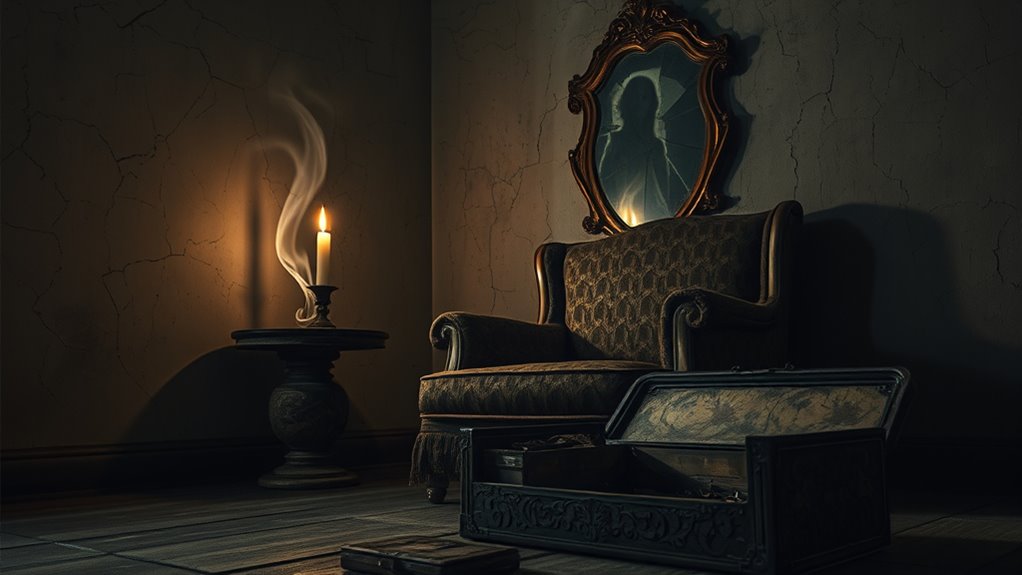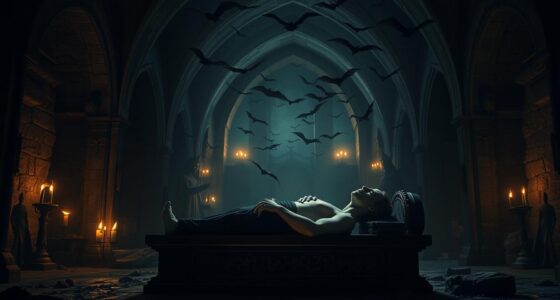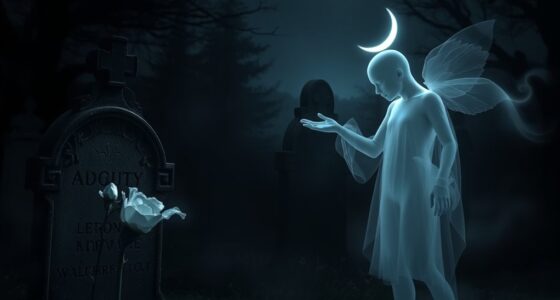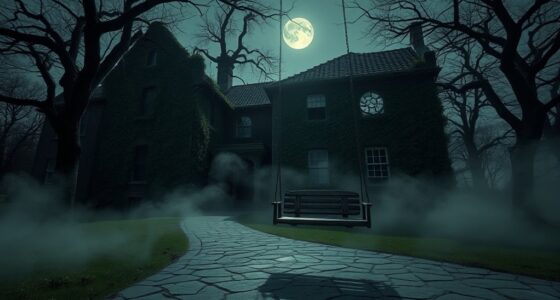Hauntings and possessions are different phenomena. When you experience a haunting, it often involves lingering spirits in specific places, like echoes of the past. Possessions, however, mean a spirit or demon is controlling a living person, leading to unsettling changes in behavior. While hauntings may evoke eerie feelings, possessions can cause fear and concern. Understanding these differences can open up new insights. Stick around to uncover more about the complexities of each experience.
Key Takeaways
- Hauntings involve spirits lingering in locations, while possessions involve a spirit or demon controlling a living person’s body.
- Intelligent hauntings feature spirits that interact with the living, whereas residual hauntings replay past events without interaction.
- Possessions can cause dramatic behavioral changes and may involve altered voices or physical transformations.
- Notable objects, like the Dybbuk Box and the Devil’s Rocking Chair, illustrate the connection between hauntings and possessions.
- Cultural beliefs greatly influence how societies interpret and respond to hauntings and possessions, shaping their perceived significance.
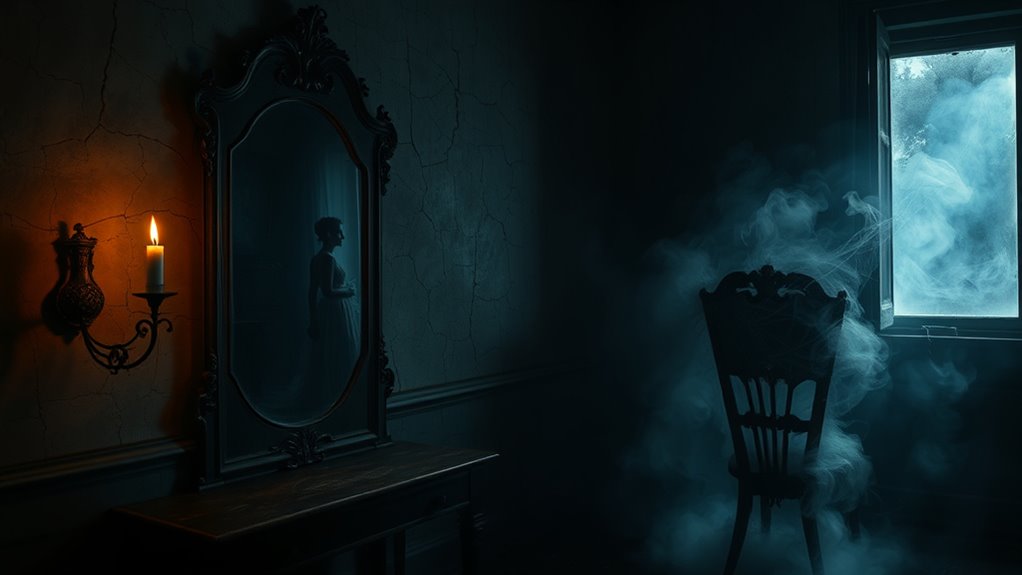
Have you ever wondered about the differences between hauntings and possessions? While both phenomena involve supernatural elements, they vary greatly in nature and impact. Hauntings typically involve the presence of spirits or ghosts lingering in a specific location. These spirits often manifest as residual energy from past events, creating an atmosphere that’s sometimes eerie but not necessarily harmful. Celebrating the bond with loved ones, such as a father and daughter, can provide emotional support during these unsettling experiences.
In contrast, possessions involve a spirit or demon taking control of a living person’s body, leading to a much more invasive and often alarming experience.
Intelligent hauntings are particularly fascinating. In these cases, spirits actively interact with the living, sometimes seeking acknowledgment or closure related to their past. You might encounter ghostly apparitions that respond to questions or appear to communicate with you.
Intelligent hauntings captivate with spirits that seek connection, often responding to the living in search of acknowledgment or closure.
On the other hand, possessions present a different narrative entirely. When an individual is possessed, they may exhibit dramatic changes in behavior, including altered voices, physical transformations, and a lack of memory about the episodes. This control can lead to frightening situations for both the possessed and those around them.
Objects like the Dybbuk Box and the Devil’s Rocking Chair illustrate the thin line between hauntings and possessions. The Dybbuk Box is infamous for allegedly containing a spirit that seeks to possess living beings, while the Devil’s Rocking Chair is tied to a tragic possession case that left a lasting mark on those involved.
These narratives often blur the lines, leading to complex psychological interpretations and cultural beliefs surrounding hauntings and possessions. Interestingly, the role of positive thinking can influence how individuals cope with fear and anxiety related to these experiences.
Cultural beliefs play a considerable role in how people perceive hauntings and possessions. Different societies have varied interpretations of these phenomena, which can affect their responses to them. Some view ghosts as benign spirits seeking help, while others may believe that possessions are punishments or tests of faith that challenge one’s beliefs.
As you explore these concepts, you’ll find that understanding the psychological interpretations behind hauntings and possessions can deepen your appreciation for these eerie experiences.
Frequently Asked Questions
What Are Some Fun Facts About Ghosts?
Imagine wandering through a misty forest, where every whisper of wind tells tales of the unseen.
Did you know that about 40% of people under 55 in the UK believe in ghosts?
Cultures worldwide celebrate spirits, like Mexico’s Day of the Dead.
Famous hauntings, like Borley Rectory, spark curiosity.
Ghosts often fall into two categories: intelligent, who interact, and residual, lingering from the past.
Fascinating, right? You’re not alone in your intrigue!
What Is the World’s Most Haunted Item?
If you’re curious about the world’s most haunted item, many would point to the Dybbuk Box. This vintage wine cabinet’s said to contain a malevolent spirit, and its owners have reported numerous misfortunes.
You might also hear about Annabelle, the Raggedy Ann doll, which paranormal experts claim harbors a demonic entity. Each of these items has eerie stories, sparking fascination and fear in those who dare to learn more about them.
Why Do Hauntings Happen?
Hauntings happen when emotions linger, when stories remain untold, and when spirits seek closure.
You might experience a ghostly presence during times of change or unrest, as unresolved feelings from the past echo in the present.
These entities often reflect their trauma or unfinished business, repeating actions tied to their lives.
Engaging with their memories can help you understand their plight, fostering healing for both the living and the deceased.
Is There Any Evidence of Paranormal Activity?
You might wonder if there’s any evidence of paranormal activity.
Most scientific research hasn’t found solid proof supporting ghosts or hauntings. Instead, studies suggest that psychological factors, like pareidolia, lead people to misinterpret ordinary stimuli as supernatural.
When you apply critical thinking, you’ll likely find that many experiences attributed to ghosts can be explained by environmental or psychological influences, rather than actual paranormal phenomena.
Conclusion
As you step into the dimly lit room, a sudden chill wraps around you, like a ghostly whisper from the past. You realize hauntings linger in familiar spaces, while possessions invade your very soul. Both phenomena evoke fear, but with distinct motives—one seeks to communicate, the other to control. Just as shadows dance in the flickering light, you understand the fine line between these eerie encounters, and the stories they tell linger long after you leave.
